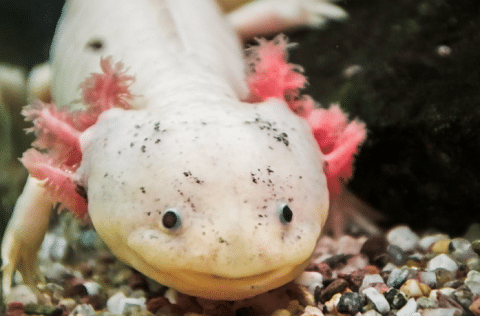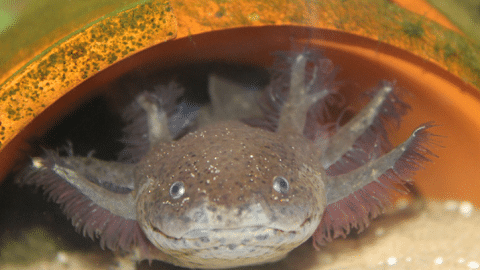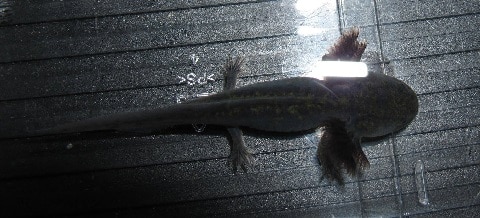Thank you for visiting! By the way… any links on this page that lead to products on Amazon and other stores/partners are affiliate links Aquarium Store Depot earns a commission if you make a purchase.
Any exotic pet lover would appreciate the cutesy looks and artistic gills of axolotls. However, I must admit; the increasing admiration and fascination of Mexican walking fish are mainly due to the bizarre axolotl morphing.
And since we’re talking about the beauty of axolotls, today, we’ll discuss 15 different color variants of axolotls with pictures.
So, sit back and relax.
What are Axolotls?

Axolotls are unique species of salamanders, mainly found in the lakebeds of Mexico city. They are very easy to look after. However, unlike other salamanders species, such as the Tiger salamander, axolotls spend their entire lives underwater.
Therefore, they require a larger tank (at least 20 gallons) with optimum temperature and water requirements.
Axolotls are critically endangered species of salamanders that are almost extinct in the wild. However, they are bred in captivity in large numbers.
One thing that should always consider before buying an axolotl is, it may require a special permit to keep an axolotl. So, to avoid any mishaps, always check with your state’s or country’s laws before getting your smiley pets.
What Causes a Wide Variety of Axolotl Morphs?
Let’s get technical.
The color variation of many aquatic animals, including axolotls is due to the pigment cells called chromatophores1. Three various types of chromatophores determine the color of your axolotl.
- Melanophores – having Eumelanin that causes a black or brown pigmentation
- Xanthophores – having Carotenoids and Pteridines that cause a yellow and red pigmentation
- Iridophores – having Crystalized Purines that cause a shiny soap-bubble type of pigmentation (Iridescence)
These three types of pigment cells possess 14 pairs of chromosomes, each coming from a male and female. The creative brains behind these clever crossover activities produce such extremely rare varieties of axolotls that we’ll discuss now.
Facts
Here’s some quick facts about the Axolotl species before we dive into morphs. Note that all axolotls you purchase from stores are captive bred. Wild species are protected and endangered.
| Scientific Name | Ambystoma mexicanum |
| Common Names | Axolotl, Mexican salamander, Mexican walking fish |
| Basic Animal Group | Amphibian |
| Size | 6-18 inches |
| Weight | 2.1-8.0 ounce |
| Lifespan | 10 to 15 years |
| Diet | Carnivore |
| Habitat | Xochimilco Lake near Mexico City |
| Wild Population | Less than a hundred |
| Current Status | Critically Endangered and Detrimental Aquatic Animals |
15 Different Types
There are numerous types of axolotls in the wild and captivity. Sadly, the native axolotls are almost extinct and we only rely on the lab-created and breed created ones to fill our places with smiley pets.
The different axolotl morphs are a result of genius genetics and thanks to genetic engineering, we can now pet some amazing axolotl morphs in our home aquariums.
Even though there is no definite color variant for axolotls, I’m going to list 15 different exotic axolotl types with pictures.
1. Leucistic

At first glance, you might confuse Leucistic axolotls with albinos. However, they are a very different and unique breed.
Leucistic morphs are pinkish-white in color with dark gray, dark brown, or black eyes with pink or red gills that make them unique pets. They usually display shiny gold flecks on a translucent body that shimmers while they swim.
Leucistic axolotls are docile and cute pets that require a simple diet and regular upkeep. However, in the daytime, they might be shy. But they are more inclined to their owners if taken good care of.
The cost of leucistic axolotls varies from $30 to $100 minus the tank accessories and food expenses.
2. Golden Albino

As juveniles, golden albinos are almost indistinguishable from white albinos. Like white albinos, they are super sensitive to bright light. However, as they age, they change color from white to peach, yellow to orange, and ultimately gold. Hence, called Golden Albinos.
The eyes of Golden albinos are usually white, pink, or yellow. And their bodies are adorned with reflective spots and speckles that shine like diamonds with peachy pink gills with a yellow hue.
In captivity, golden albinos are common species that cost around $50 minus the tank and food expenses.
3. Wild Type

As the name suggests, the wild-type axolotls mimic the appearance of the native Axolotls found in the muddy lakebeds near Mexico city. This type of axolotl is dark grayish-green in color with black or olive mottling. They also showcase a pale abdomen and gold speckles on their body.
The essence of this morphed axolotl lies in the purple gill filaments and dark eyes surrounded with golden irises. The cost of wild axolotls type ranges anywhere from $40 to $50, depending on the individual reptile and they are a very common axolotl morph in captivity.
4. Piebald
It is fairly easy to spot a piebald axolotl (video source) in an axolotl galore due to the pigmentation on the sides of the body. And just like other axolotl morphs, they are easy to care for and keep. A piebald axolotl has darker and thicker black spots than other axolotls morph.
Piebald axolotls are white with red gills, which makes them identical to Leucistic. However, they have black eyes and black symmetrical patches on the back and face that make them easily distinguishable.
Piebald axolotl morphs are rare. Hence, costs around $300.
5. Mosaic
Talk about exotic morphs in exotic pets, and we get a mosaic axolotl!
The mosaic axolotl is a product of wild type and leucistic morph colors that are spread all over the body. Mosaic axolotls are mottled with black and white colors and a hint of golden flecks on their body. They possess gills that are striped with red and purple colors and eyes that are multi-color, Imagine the beauty!
However, if you plan to breed these species, chances are you’re going to fail. They are a result of beautiful accidents and cannot be bred. Hence, very rare and costlier than most morphed axolotls.
6. Copper
When we’re talking about copper axolotls (video source), we’re generally speaking about a special type of albino that comes in various copper axolotl colors. They range from light, medium, to dark copper colors with reddish eyes. Mostly, copper axolotls are divided into three groups:
- Light Coppers
- Coppers
- Het Coppers
One way to distinguish a copper axolotl from any other morphed axolotl is by shining a flashlight at their eyes. When pupils reflect red color, know that you have an albino copper axolotl.
Also, there’s the rarest breed of Copper axolotl namely Copper Melanoid axolotl, but one can get it only by luck!
7. Lavender or Silver Dalmatian
A very popular morph in the USA due to the cool color is a Lavender axolotl. This axolotl morph has light purple hints to its body with red gill filaments and black eyes. Usually, the body is covered in gray spots and that’s where they get their name from – Silver Dalmatian (Picture of breed is located here).
Sometimes, these lavender axolotl morphs change their color from purple to gray or green. However, mostly it remains the same.
Lavender morphs are rare yet desirable due to their color and unique specks all over the body. The lavender morphs cost around $115 and are mostly sold in the U.S.A.
8. Black Melanoid
Black melanoids (video source) are usually known as Blue Axolotls. However, they are not blue at all. Due to different lighting, black melanoid axolotls might appear bluish, but they have a dark black body and alight, pale-colored stomach.
Unlike most axolotl morphs, they don’t possess shiny spots on their bodies. Since they are dark in color, a black melanoid can usually be confused with the wild variety.
If this confusion occurs, look closely at the eyes of your axolotl, if there is a shiny ring around the pupil, your axolotl is not a Black melanoid and a wild one instead.
9. White Albino
White albinos (video source) are a close relative of leucistic morphs that are pure white with red gill filaments. They also have light-colored eyes particularly, white or pink. On their gill stalks, there are flecks of gold. Due to the absence of pigments in their eyes, they are sensitive to light and may have poor vision.
One distinctive feature of white albinos is their dark fingertips that appear dirty when the axolotl reaches maturity. They are usually bred in captivity and cost around $40.
10. Speckled Leucistic or Dirty Leucistic or Dirty Lucy
Speckled leucistic (video source) is exactly the same as regular leucistic besides they have black, dark green, or brown spotting or specklings on the face and upper body. The black specklings on their body vary depending on the age of the axolotl and it is more prominent when the axolotl resides on a dark substrate.
If you keep your dirty Lucy in clean water with fewer predators, the black spots will disappear.
Fun Fact: The dirty black spots keep your dirty Lucy safe from predators by maintaining a camouflage.
11. Chimera
Chimera is the result of two egg morphs when fused before hatching. And this is the reason you’ll rarely find Chimera in the wild but in captivity only.
They are usually not considered true axolotl morph as they possess one morph on one side of their body and a different morph on the other. The axolotl morph is then split right down into the middle and right halves.
Interestingly, depending upon the individual axolotl, one side of the morph can grow significantly at a slower pace than the other. Chimerism in axolotls is extremely rare, and they are not sold in the markets.
Fun Fact: The chance of the birth and survival of Chimera is about 0.00001%!
12. Heavily-Marked Melanoid

When we talk about melanoid, it is usually misunderstood that there are no axolotl colors. However, the literal definition of melanoid in the axolotl hall of fame is “the absence of iridophores (shiny patches).”
Heavily-marked melanoid axolotls are a unique variation of black melanoid morph that is black with grayish purple spots.
These color morphs are rare and there is little to no information available about them.
The light green and yellow patches on their body make them highly distinguishable from a regular black melanoid. They are uncommon in the wild and captivity as well and sold for around $75.
13. Green Fluorescent Protein
Glow in the dark axolotl might be a stunning surprise for you. However, they are for real (video source).
GFP or Green fluorescent protein radiates a bright neon green color under blacklight. But blacklight is detrimental to these adorable creatures, so they shouldn’t be exposed to it for more than a few seconds.
You’ll experience some greenish tint on your GFP axolotls under a normal lighting and their eyes will radiate green color, even under normal room lighting.
Originally, the green fluorescent protein was artificially introduced into the axolotl community by the Max Planck Institute in 2005 to give axolotls a glow-in-the-dark effect. However, now they may naturally occur in some species.
The purpose of mutating this genetically modified axolotl morph was to research cancer and the regeneration process. On average, you will find GFP axolotls almost everywhere and they cost around $70.
14. Firefly
The genius brain behind Firefly axolotls is Lloyd Strohl II from Indiana USA in 2016, who artificially created this axolotl morphing through embryonic graphing to study limb regeneration.
The firefly axolotls have a lighter tale and a darker body or vice versa. Out of which, some have GFP tails that glow in the dark.
Since this morphed axolotl was created in a lab, they are rarely found and sold. Since they possess a GFP tail, their tails are fluorescent under UV or black light and hence the name, “Firefly.”
They are not easily found in captivity and cost around $250.
15. Enigma
Enigma (picture source) is another artificially created axolotl morph for the sake of research by an American hobbyist. Therefore, they are sold only in the U.S.A.
Enigma axolotls have a dark gray body with translucent underbelly and toes. They possess pale red gills and beautiful golden eyes.
They often display a green-golden patch that grabs attention. Enigma axolotls are derived from the wild types.
All in all, each axolotl morph is an endangered species that demand your attention. Therefore, breeders and keepers should play their part in keeping axolotl’s waters clean and their diet healthy.
FAQs
What is the rarest Color?
The Lavender morph or Silver Dalmation is the rarest axolotl color as they can only be found in some parts of the U.S.A.
What is the rarest type?
The piebald axolotl is by far the rarest axolotl morph, which is a leucistic axolotl morph with pigments in other parts of its body other than the face.
What is the rarest in real life?
Mosaic and Chimera axolotls are very rare in real life.
Conclusion
That’s all about exotic axolotl breeds for now. If you want one for yourself, I suggest that you check with your local breeders after getting the permit, and decide which one you’d like to get for your home aquariums.
Whatever morph you get, be sure to provide it with enough space to roam around freely and feed nourishing live food (especially live earthworms) to keep them healthy and happy for the rest of their lives.
- About the Author
- Latest Posts
I’m thrilled that you found Aquarium Store Depot! Here you’ll find information on fish, aquariums, and all things aquatics related. I’m a hobbyist (being doing this since I was 11) and here to help other hobbyists thrive with their aquariums! I adhere to a high quality Editorial Process and Review products with real life field usage and practical analysis.






Thanks for all the facts about the axolotls! I needed them, a LOT! 🙂